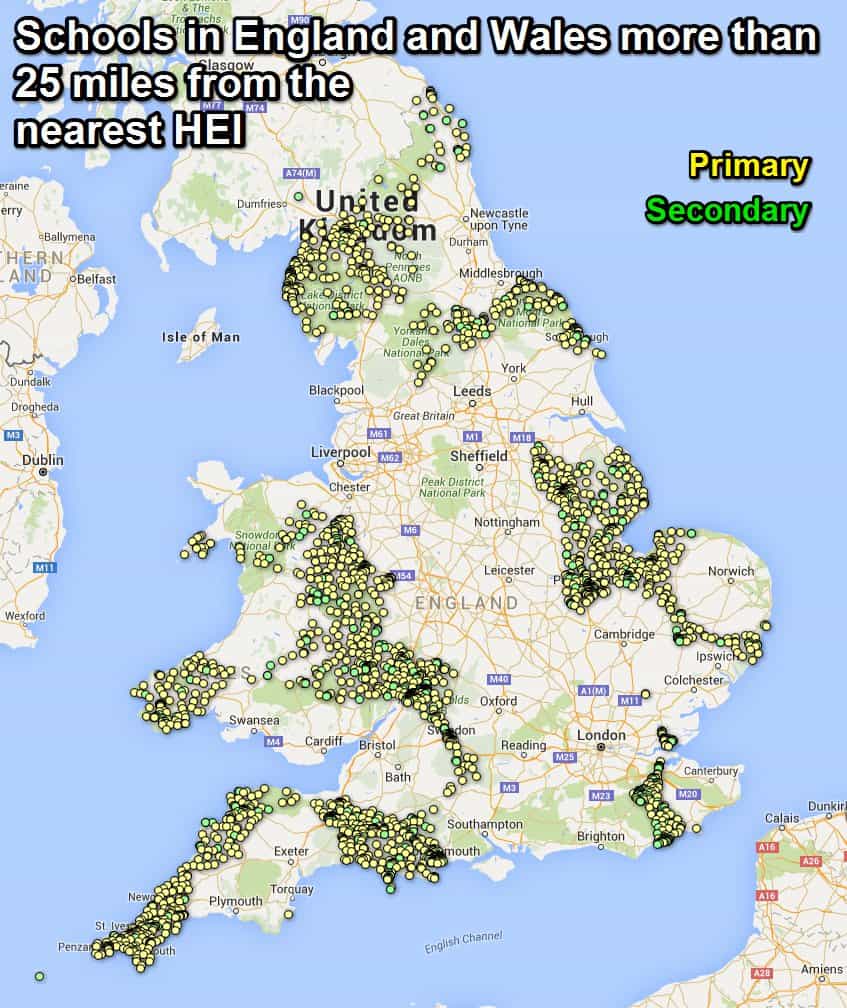In September last year we wrote about Widening Participation. We’ve refined our criteria a little since then; below is our definition of a widening participation school.
We’ve decided on these criteria because they match, in broad terms, the kinds of criteria universities use to identify widening participation students.
A widening participation school is…
In England and Wales
- A school in an area where POLAR3 is in the first quintile, or…
- A school where the % of students eligible for free school meals is higher than 41%, or…
- A school where the % of students achieving 5 grades A*–C at KS4 is below 45%, or…
- A school where the % of students level 4 in reading, writing, and maths at KS2 is below 45%, or…
- A school more than 25 miles from their nearest HEI.
In Scotland
- A school in a remote rural area, or a remote small town
Where an independent school matches the criteria it will not be counted as a widening participation school.
Distance as measure
The Aspires project, from King’s College London found that science capital is a key factor in terms of students aspiring to a science-related career. Science capital refers to knowledge about science and how it works, interest, understanding, and contacts (knowing somebody who works in science).
We think that one of the most substantial factors limiting students’ science capital is the ability for those students to have contact with STEM professionals; to meet scientists who they can relate to. This is where an online activity, like I’m a Scientist, has a great advantage. There is no distance barrier, no travel time. A scientist in central Manchester can have a live chat with a school in Cornwall followed immediately with a school in the Highlands.
To this end, we’ve added to our criteria: A school will count as distant if it is more than 25 miles from a major research higher education institute (HEI).
Starting with England and Wales, we took all of the schools, mapped the distance to the top 70 institutions by research output, and worked out the shortest distance between a school and a university. The map shows the schools which are more than 25 miles from one of these institutions.
We did not include smaller institutions, or those with more focused research areas as contact with scientists working in a wide variety of subjects and fields is important.
In Scotland the Department for Education lists schools with an urban/rural classification. Largely this covers what we are looking to achieve with the distance analysis in England and Wales (though we do plan to add HEI distance data for Scotland and Northern Ireland).
In Scotland, a school in a remote rural area, or remote small town will count as widening participation.
This measure excludes schools in accessible and urban areas; in effect the schools accessible from universities.
What about the most recent event?
In June 2016, by prioritising places for widening participation schools (meaning teachers at those schools are more likely to be given additional classes), 27% of the students taking part in I’m a Scientist came from widening participation schools.
21% of the schools taking part in June 2016 were widening participation schools.
Last year, in June 2015 we reported that 16% of the classes taking part were from schools meeting our criteria.
What’s next?
- Targets — By 2020, our aim is that 30% of the schools taking part meet the widening participation criteria.
- More data — We’re missing criteria for schools in Northern Ireland, and we’re missing attainment data for schools in Scotland. We need to add this.
- Improving the definition of schools in relation to their nearest HEI — Do we need to look at creating a more nuanced definition of distant schools in England and Wales? The current definition looks at distance rather than travel time. Travel time is likely a better measure but more difficult to assess. We would also like to look in more detail at the level of outreach different schools are receiving.
- A new database — We’re in the process of building a database of all UK schools which will be integrated into the teacher application process. This will allow us to more easily identify and allocate places to priority schools. It will also open new reporting features to teachers, giving schools more data on how their students are using the projects.


Recent Comments
No comments to display